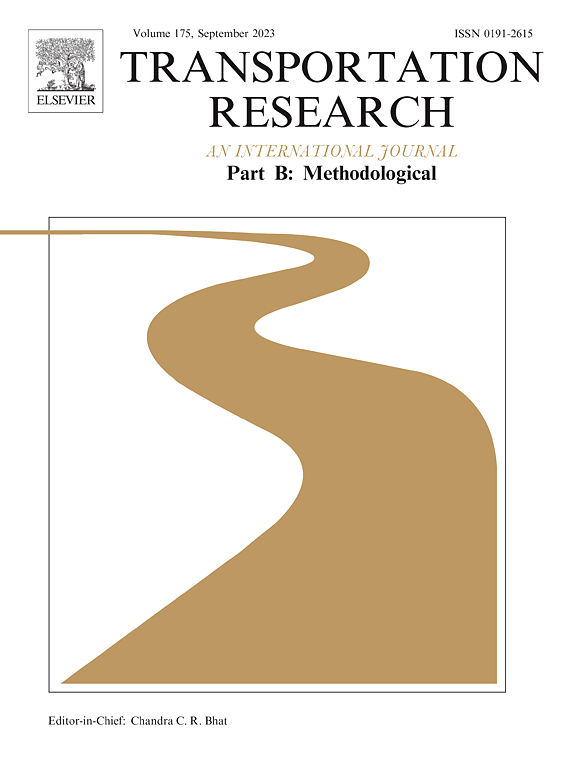考虑异方差、重叠和选择集形成的封闭式有界路径选择模型
IF 6.3
1区 工程技术
Q1 ECONOMICS
引用次数: 0
摘要
多项Logit (Multinomial Logit, MNL)模型由于其简单的封闭式选择概率函数,在路径选择建模中得到了广泛的应用。然而,MNL假设误差项是独立的、同分布的,具有无限支持。结果,它施加了同方差性,这意味着长途和短途旅行共享相同的误差方差,忽略了重叠路线之间的相关性,并为所有可用路线分配非零选择概率,而不考虑其成本。本文通过开发一个封闭形式的路径选择模型来解决这些限制。引入有界q-积Logit (Bounded q-Product Logit, BqPL)模型,该模型包含有界支持的异方差误差项。参数q控制错误项方差随行程成本增加的速率,违反成本界限的路由获得零选择概率,隐式地定义了路由选择集。此外,我们扩展了BqPL模型,通过在选择概率函数中集成路径大小校正项来考虑重叠路径之间的相关性,从而得到有界路径大小q-乘积Logit (BPSqPL)模型。我们说明了BPSqPL模型在小规模网络上的特性,并将其与一系列现有的选择模型进行了对比。然后,我们提出了一种方法来估计模型参数和标准误差,使用自举。最后,我们用一个大规模的自行车路线选择案例来评估模型,比较其拟合优度、可解释性和预测能力与相关的崩溃模型。我们还测试了选择集大小对估计参数的影响。研究结果强调了解决MNL模型的三个关键局限性的重要性,并证明了BPSqPL模型在这方面的有效性。本文章由计算机程序翻译,如有差异,请以英文原文为准。
A closed-form bounded route choice model accounting for heteroscedasticity, overlap, and choice set formation
The Multinomial Logit (MNL) model is widely used in route choice modelling due to its simple closed-form choice probability function. However, MNL assumes that the error terms are independently and identically distributed with infinite support. As a result, it imposes homoscedasticity, meaning that long and short trips share the same error variance, disregards correlations between overlapping routes, and assigns non-zero choice probabilities to all available routes, regardless of their cost. This paper addresses these limitations by developing a closed-form route choice model. We introduce the Bounded q-Product Logit (BqPL) model, which incorporates heteroscedastic error terms with bounded support. The parameter controls the rate at which error term variance increases with trip cost, and routes that violate cost bounds receive zero choice probabilities, implicitly defining the route choice set. Furthermore, we extend the BqPL model to account for correlations between overlapping routes by integrating path size correction terms within the choice probability function, resulting in the Bounded Path Size q-Product Logit (BPSqPL) model. We illustrate the properties of the BPSqPL model on small-scale networks, contrasting it with a range of existing choice models into which it can collapse. We then present a method to estimate the model parameters and standard errors, using bootstrapping. Finally, we estimate the model using a large-scale bicycle route choice case study, comparing its goodness-of-fit, interpretability, and forecasting ability with relevant collapsing models. We also test the impact of the choice set size on the estimated parameters. The results underscore the importance of addressing the three key limitations of the MNL model and demonstrate the effectiveness of the BPSqPL model in doing so.
求助全文
通过发布文献求助,成功后即可免费获取论文全文。
去求助
来源期刊
CiteScore
12.40
自引率
8.80%
发文量
143
审稿时长
14.1 weeks
期刊介绍:
Transportation Research: Part B publishes papers on all methodological aspects of the subject, particularly those that require mathematical analysis. The general theme of the journal is the development and solution of problems that are adequately motivated to deal with important aspects of the design and/or analysis of transportation systems. Areas covered include: traffic flow; design and analysis of transportation networks; control and scheduling; optimization; queuing theory; logistics; supply chains; development and application of statistical, econometric and mathematical models to address transportation problems; cost models; pricing and/or investment; traveler or shipper behavior; cost-benefit methodologies.

 求助内容:
求助内容: 应助结果提醒方式:
应助结果提醒方式:


